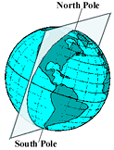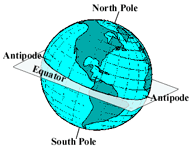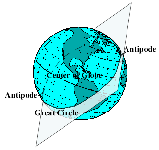Day 167 : FTFE Hit The First Antipode!
Today we had three objectives; to find the FTFE antipode (very very important for completing our Guinness World Record attempt), to get some awesome footage of Auckland for the documentary, and last but not least, to find an outfit for the New Years Eve party theme ‘when I was 11’. How hard could it be? We met cameraman Dave Flynn http://www.inlikeflynn.co.nz bright and early to start our magical mystical tour of Auckland. Everyone leaves Auckland for the holidays (most people don’t go back to work until 17th January!) so we had the roads to ourselves, sweet as!
The first stop was St Heliers beach for a bit of posing then onto Michael Joeseph Savage Memorial Park, named after the first Prime Minster. The cricket set came out for the camera and the last test of 2010 commenced, girls v boys. The boys were taking it all a little bit too seriously as usual but the girls came up trumps, catching S. Moore out twice to hold the car park cricket test title for 2010. Nice one Povey! Everyone knows you’re only as good as your last game Steve Moore. At the park there was quite a lot of interest in the fire engine with people asking if they could take Martha’s picture and excited kids climbing all over her. Whilst Steve was being interviewed in front of the camera a women came over and interrupted, we all thought she wanted her picture taken with ‘celebrity’ Steve. No, she’d interrupted to ask him to take her picture, brilliant! Next we drove to Auckland Viaduct to film what felt like an episode of ‘Wish you were here’. As we strolled around the harbour gazing at restaurants and yachts longingly, Dave was never far behind.The most important job of the day was hitting the antipode. ‘A true circumnavigation of the world must pass through two points antipodean to each other.’ Norris McWhirter, founding editor of Guinness, 1971. Which means Martha must drive through two points on the earth’s surface directly opposite to each other. To cross a pair of antipodal points means automatically crossing and traveling the minimum distance of the equator, and spending equal time in both southern and northern hemispheres. If you were to drill through the centre from Mount Eden in a line you would come out at a barn in the South of Spain. First antipode Mount Eden, big big tick for Martha and Follow That Fire Engine!
Right, now time for New Year’s eve outfits and onto the only fancy dress shop open in the city. The boys soon had their outfits sussed, super heros, easy. The problem Kate and I had was every outfit the word ‘naughty’ in front of it… a naughty police women, naughty nurses, naughty librarians, naughty Pocahontas, you think of it, they’ve ‘naughty-ed it’. We opted for ‘naughty nuns’ outfits to be worn with trainers as we were 11 in 1990 when the film Nuns on the Run hit the big screens, not an obvious choice but beggars can’t be choosers. Fancy dress, tick!
After another bit of filming it was time to go and make ourselves look beautiful and holy for the evening. Mission complete, its tiring being a filmstar. We’d like to say hello to all the people we met today who were interested in our story and a Happy New Year to all Follow That Fire Engine Followers!
Amy
[flickr album=72157625662247073 num=30 size=Square]
.
More on Antipodes and Great Circles from http://www.expedition360.com
To understand the significance of antipodal points in a true circumnavigation one must first define something called a Great Circle: the largest circle which can be drawn on the surface of globe by a plane cutting through the sphere at its centre. All longitudes are Great Circles because the plane cutting through every meridian of longitude cuts through the centre of globe as well as the north and south poles.
Following a Great Circle inevitably entails crossing a pair of Antipodal Points en route, and as such is the only way of ensuring a fair circumnavigation is achieved regardless of where on the planet a traveler starts from.
 |
|
If you put planes through the latitudes, only the one through the equator will also cut through the centre of the globe and therefore can be said to be a Great Circle.
It would be easy if everyone could follow one of these Great Circles, but for practical reasons this is impossible.
Ironically employing a human powered method of travel offers perhaps the greatest opportunity of achieving one of these ideal circumnavigations.
 |
|
The simplest and most effective way to prove that a circumnavigation attempt followed a Great Circle is to put the plane through any point of the prospective route and through the centre of the globe, and then to find the opposite point on that plane – the point called the antipode. Simply put, if somebody’s journey crosses at least one pair of antipodes, they traveled a Great Circle and can therefore claim a ‘true’ circumnavigation. This also ensures that:
> the equator is crossed at least twice
> a distance that is equal to or more than the length of the Equator (40.075 km) is traveled
 |























